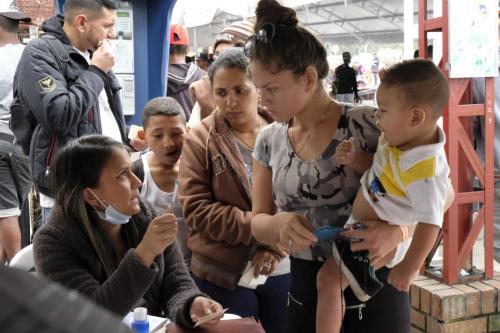Emergency plan for refugees and migrants from Venezuela launched
Faced with the largest population outflow in Latin America of recent years, 95 organizations covering 16 countries have been working together to establish a comprehensive response to the urgent needs of millions of refugees and migrants from Venezuela, and host communities. This effort is coordinated by UNHCR, the UN Refugee Agency, and IOM, the International Organization for Migration.

Venezuelans arrive at Rumichaca International Bridge, the main point of entry into Ecuador from Colombia, November 2018.
Launched in Geneva, the regional Refugee and Migrant Response Plan (RMRP) is the first of its kind in the Americas, on December 14: an operational blueprint, coordination template and strategy for responding to the needs of Venezuelans on the move and securing their social and economic inclusion in the communities receiving them.
The RMRP, which is also an appeal for funding, focuses on four key areas: direct emergency assistance, protection, socio-economic and cultural integration and strengthening capacities in the receiving countries.
“This plan is a call to the donor community, including international financial institutions and development actors who can play a key role in this situation, to increase their support to refugees and migrants in the region and the host communities which have kindly opened their arms to them,” said Eduardo Stein, Joint UNHCR-IOM Special Representative for Venezuelan refugees and migrants.
“Venezuelans I met during my visits spoke of hunger, lack of access to medical care, insecurity, threats, fear. They are families, women alone, children, young boys and girls, all in conditions of extreme vulnerability. All of them saw no other option than to leave their country –sometimes walking for days- seeking to live in dignity and to build a future,” Stein said, adding that this critical situation is exacerbated by the lack of livelihoods, which exposes refugees and migrants to all forms of exploitation.
Although Venezuelans have been leaving their country for several years, these movements increased in 2017 and further accelerated in 2018. According to available estimates, during 2018 an average of 5,500 people have been leaving the country every day.
“The solidarity of Latin American countries with Venezuelans has been humbling. It is now vital that we stabilize the dire humanitarian situation affecting the millions of Venezuelans seeking protection and shelter across the continent,” said UN High Commissioner for Refugees Filippo Grandi, on December 14. “The appeal launched today underscores the urgency of this complex and fast-evolving situation and the need to support the host communities. ”
RMRP funding requirements in 2019 amount to US$ 738 million. Interventions will target 2.7 million people in 16 countries, 2.2 million of them Venezuelans and 500,000 people in host communities.
“IOM is committed to expanding its support to governments across Latin America and the Caribbean who have extended assistance and solidarity to Venezuelan migrants over the past year,” IOM Director General António Vitorino said. “We call on the donor community to generously support this regional plan.”
Solidarity and responsibility-sharing from the international community are desperately needed, not only for Venezuelan nationals, but also for the governments and citizens of destination countries. They have been at the forefront of the response to the outflow, including through regional initiatives such as the Quito Process, and have demonstrated extraordinary generosity towards the refugees and migrants, in some cases for years. Their ability to cope and their infrastructure are being stretched beyond capacity.
“There are significant gaps and challenges, particularly regarding documentation, regularization, capacity of asylum systems, and access to basic services such as health and education, shelter and protection,” said Mr. Stein.
To date, most Venezuelan refugees and migrants have arrived initially in neighbouring Colombia. While some remain there, many have moved onwards, mainly to Ecuador, Peru, and to a lesser extent Chile and Argentina. Meanwhile Brazil has become another major destination. Mexico, Caribbean and Central American countries have so far witnessed a smaller number of arrivals, either directly or through secondary movements. These trends are likely to continue in 2019.
Source: United Nations High Commissioner for Refugees
- 298 reads
Human Rights
Ringing FOWPAL’s Peace Bell for the World:Nobel Peace Prize Laureates’ Visions and Actions

Protecting the World’s Cultural Diversity for a Sustainable Future

The Peace Bell Resonates at the 27th Eurasian Economic Summit

Declaration of World Day of the Power of Hope Endorsed by People in 158 Nations

Puppet Show I International Friendship Day 2020

